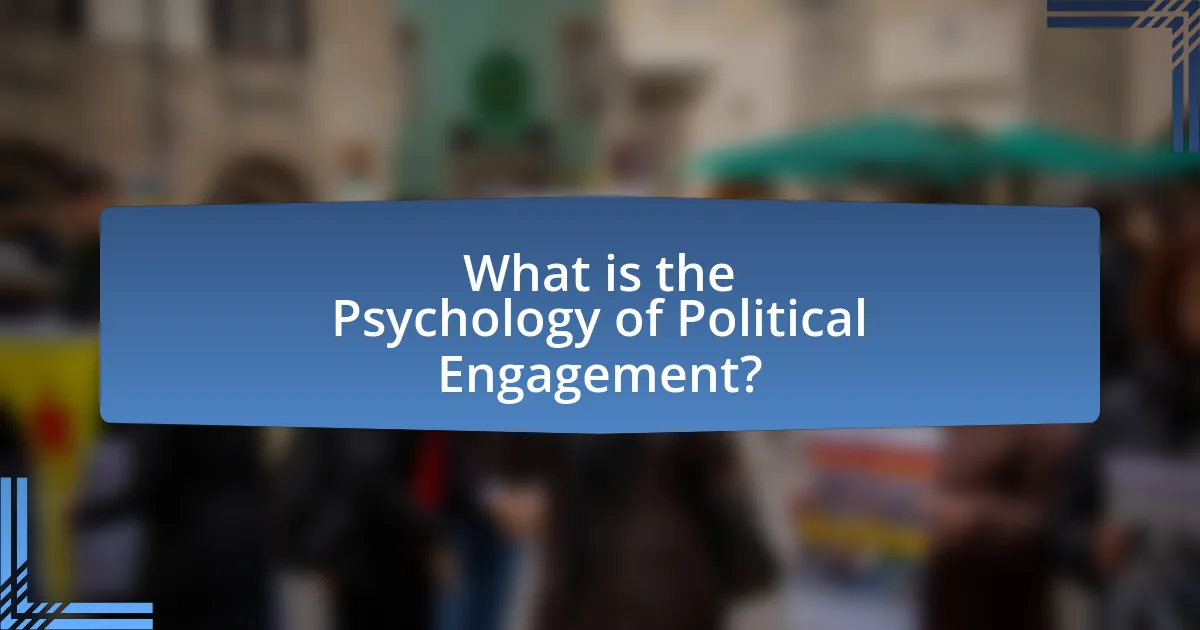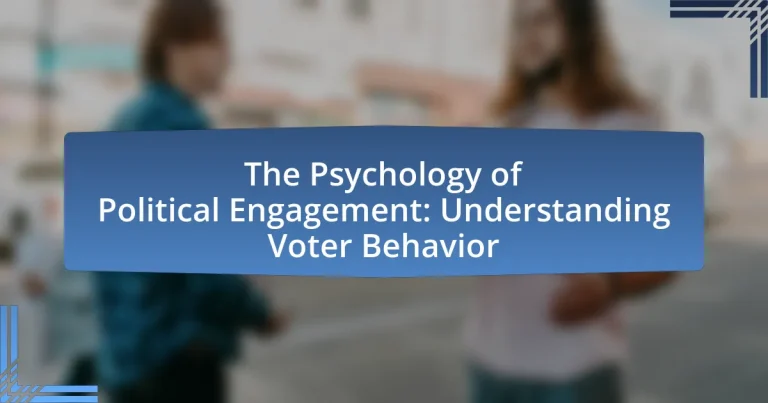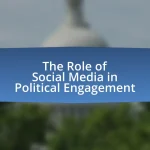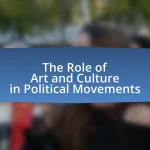The article focuses on the psychology of political engagement, examining the mental processes and emotional factors that drive individuals to participate in political activities such as voting and advocacy. It explores key concepts including political efficacy, social identity, cognitive biases, and emotional responses, all of which significantly influence voter behavior and decision-making. The article also discusses the impact of demographic variables, media consumption, and misinformation on voter engagement, while highlighting strategies to enhance political participation through grassroots movements and social media campaigns. Understanding these psychological factors is crucial for predicting electoral outcomes and improving political strategies.

What is the Psychology of Political Engagement?
The psychology of political engagement refers to the mental processes and emotional factors that influence individuals’ participation in political activities, such as voting, campaigning, and advocacy. This field examines how personal beliefs, social identities, and cognitive biases shape political behaviors and attitudes. Research indicates that factors like political efficacy, which is the belief that one’s actions can influence political outcomes, significantly affect voter turnout. For instance, a study by Campbell et al. (1960) in “The American Voter” highlights that individuals with higher political efficacy are more likely to engage in voting and other political activities. Additionally, social identity theory suggests that individuals are motivated to engage politically when they identify strongly with a particular group or cause, reinforcing the connection between personal identity and political action.
How does psychological theory explain voter behavior?
Psychological theory explains voter behavior primarily through concepts such as cognitive dissonance, social identity, and motivation. Cognitive dissonance suggests that individuals experience discomfort when their beliefs conflict with their actions, leading them to rationalize their voting choices to align with their self-image. Social identity theory posits that voters identify with specific groups, influencing their political preferences and behaviors based on group norms and values. Additionally, motivation plays a crucial role; factors such as personal interests, perceived efficacy, and emotional responses can drive individuals to participate in elections. Research indicates that these psychological factors significantly impact voter turnout and decision-making processes, as evidenced by studies showing that individuals are more likely to vote when they feel a strong connection to their social identity and believe their vote matters.
What are the key psychological factors influencing voter decisions?
Key psychological factors influencing voter decisions include cognitive biases, social identity, emotional responses, and heuristics. Cognitive biases, such as confirmation bias, lead voters to favor information that aligns with their pre-existing beliefs, impacting their decision-making process. Social identity influences voter behavior as individuals often align their choices with the groups they identify with, such as political parties or demographic categories. Emotional responses, including fear and hope, can significantly sway voter preferences, as candidates often evoke these feelings to mobilize support. Heuristics, or mental shortcuts, allow voters to make quick decisions based on limited information, often relying on candidate traits or party affiliation rather than detailed policy analysis. Research by Campbell et al. (1960) in “The American Voter” highlights how these psychological factors shape electoral outcomes by affecting perceptions and motivations.
How do emotions play a role in political engagement?
Emotions significantly influence political engagement by shaping individuals’ motivations and actions in the political sphere. Research indicates that emotions such as fear, anger, and hope can drive voter turnout and participation in political activities. For instance, a study published in the journal “Political Psychology” by Brader (2006) found that emotionally charged political advertisements increased voter mobilization by eliciting strong emotional responses. Additionally, emotions can affect how individuals process political information, leading to biased interpretations that align with their feelings, as demonstrated in the work of Westen (2007) in “The Political Brain.” Thus, emotions serve as a critical factor in determining the level of political engagement among individuals.
Why is understanding voter behavior important?
Understanding voter behavior is important because it informs political strategies and policies that resonate with constituents. By analyzing how demographics, social influences, and individual motivations affect voting decisions, political parties can tailor their campaigns to address the specific needs and concerns of the electorate. For instance, research from the Pew Research Center indicates that understanding factors such as age, education, and socioeconomic status can significantly predict voting patterns, allowing for more effective outreach and engagement efforts. This knowledge ultimately enhances democratic participation and ensures that elected officials are more representative of their constituents’ interests.
What impact does voter behavior have on election outcomes?
Voter behavior significantly influences election outcomes by determining which candidates or policies receive support. For instance, high voter turnout often correlates with the success of candidates who mobilize their base effectively, as seen in the 2008 U.S. presidential election, where Barack Obama’s campaign engaged younger voters, leading to a turnout increase of 2.5 million compared to the previous election. Additionally, voter preferences shaped by factors such as demographics, socioeconomic status, and political ideology can sway results; in the 2020 election, for example, shifts in suburban voter behavior contributed to Joe Biden’s victory in key battleground states. Thus, understanding voter behavior is crucial for predicting and analyzing election outcomes.
How can insights into voter psychology improve political campaigns?
Insights into voter psychology can significantly enhance political campaigns by enabling candidates to tailor their messaging and strategies to resonate with specific voter motivations and concerns. Understanding psychological factors such as cognitive biases, emotional triggers, and social influences allows campaigns to craft targeted communications that effectively engage voters. For instance, research by the Pew Research Center indicates that emotional appeals can increase voter turnout by creating a sense of urgency and connection to the issues at stake. Additionally, insights into group identity and social norms can help campaigns leverage community dynamics, fostering a sense of belonging that encourages voter participation. By applying these psychological insights, campaigns can optimize their outreach efforts, ultimately leading to improved electoral outcomes.

What are the main theories of voter behavior?
The main theories of voter behavior include the Rational Choice Theory, the Sociological Theory, and the Psychological Theory. Rational Choice Theory posits that voters make decisions based on a cost-benefit analysis, weighing the potential outcomes of their choices. Sociological Theory emphasizes the influence of social factors such as class, religion, and ethnicity on voting behavior, suggesting that these demographics shape political preferences. Psychological Theory focuses on individual psychological factors, including attitudes, beliefs, and emotions, which affect how voters perceive candidates and issues. These theories are supported by empirical research, such as the American National Election Studies, which demonstrate how various factors influence voter decisions in different contexts.
How do social identity and group dynamics influence voting?
Social identity and group dynamics significantly influence voting behavior by shaping individuals’ political preferences and decisions through a sense of belonging and group loyalty. Research indicates that individuals often align their voting choices with the political affiliations of their social groups, such as family, friends, or community organizations, which can lead to a phenomenon known as social conformity. For instance, a study by Campbell et al. (1960) in “The American Voter” demonstrates that voters are more likely to support candidates who reflect the values and beliefs of their social identity groups. Additionally, group dynamics, such as in-group favoritism and out-group bias, can further reinforce voting patterns, as individuals may prioritize the interests of their group over others, impacting electoral outcomes.
What role does group affiliation play in voter decision-making?
Group affiliation significantly influences voter decision-making by shaping individuals’ political preferences and behaviors. Research indicates that voters often align their choices with the values and beliefs of their social groups, such as political parties, ethnic communities, or interest groups. For instance, a study by Campbell et al. (1960) in “The American Voter” demonstrates that individuals are more likely to support candidates who reflect the ideologies of their affiliated groups, highlighting the impact of social identity on electoral choices. This alignment occurs because group affiliation provides a framework for interpreting political information and mobilizing collective action, ultimately guiding voters toward decisions that reinforce their group identity.
How does social pressure affect voter turnout?
Social pressure significantly increases voter turnout by motivating individuals to participate in elections due to the influence of their social networks. Research indicates that when people perceive that their friends, family, or community expect them to vote, they are more likely to engage in the electoral process. For instance, a study published in the American Political Science Review found that social pressure can raise turnout rates by as much as 8% when individuals are reminded of their civic duty by peers. This effect is particularly pronounced in close-knit communities where social norms strongly emphasize participation in civic activities.
What cognitive biases affect voter choices?
Cognitive biases significantly influence voter choices, with several key biases being particularly impactful. Confirmation bias leads voters to favor information that aligns with their pre-existing beliefs, often disregarding contradictory evidence. Anchoring bias causes individuals to rely heavily on the first piece of information they encounter, which can skew their perception of candidates or issues. Additionally, the bandwagon effect drives voters to support candidates who appear to be popular, as they seek to align with perceived majority opinions. Research indicates that these biases can shape electoral outcomes by affecting how voters process information and make decisions, ultimately influencing the democratic process.
How does confirmation bias shape political opinions?
Confirmation bias shapes political opinions by leading individuals to favor information that aligns with their pre-existing beliefs while dismissing contradictory evidence. This cognitive tendency results in a skewed perception of political realities, as individuals selectively seek out news sources, social media content, and discussions that reinforce their viewpoints. Research indicates that people are more likely to remember and share information that supports their political stance, further entrenching their beliefs. For instance, a study published in the journal “Political Psychology” by Nyhan and Reifler (2010) demonstrated that individuals exposed to corrective information often rejected it if it conflicted with their political identity, illustrating how confirmation bias can distort understanding and engagement in political discourse.
What is the impact of the bandwagon effect on elections?
The bandwagon effect significantly influences elections by causing voters to align with candidates perceived as popular or likely to win. This psychological phenomenon leads to increased support for candidates who are already gaining traction, often resulting in a self-reinforcing cycle where popularity begets more popularity. For instance, during the 2008 U.S. presidential election, Barack Obama experienced a surge in support after early primary victories, demonstrating how perceived momentum can sway undecided voters. Studies indicate that voters are more likely to choose candidates who they believe have a higher chance of winning, thereby amplifying the bandwagon effect’s impact on electoral outcomes.

What factors contribute to political engagement?
Political engagement is influenced by several key factors, including education, socioeconomic status, social networks, and political efficacy. Education enhances awareness of political issues and processes, leading to higher participation rates; for instance, individuals with a college degree are significantly more likely to vote compared to those without. Socioeconomic status affects access to resources and information, with higher income levels correlating with increased political activity. Social networks, such as family and friends, play a crucial role in shaping political attitudes and encouraging participation, as individuals are more likely to engage when surrounded by politically active peers. Lastly, political efficacy, or the belief that one’s actions can influence political outcomes, drives individuals to participate; research indicates that those who feel empowered are more likely to vote and engage in civic activities.
How do demographic variables influence voter behavior?
Demographic variables significantly influence voter behavior by shaping individuals’ political preferences and participation levels. Factors such as age, gender, race, education, and income affect how people identify with political parties and issues. For instance, younger voters tend to lean more towards progressive policies, while older voters often favor conservative stances, as evidenced by the 2020 U.S. presidential election where 50% of voters aged 18-29 supported Joe Biden compared to 47% for Donald Trump, while voters aged 65 and older favored Trump by 52% to Biden’s 47%. Additionally, racial and ethnic backgrounds play a crucial role; for example, Black and Hispanic voters overwhelmingly supported Democratic candidates in recent elections, reflecting their concerns about social justice and immigration policies. Education levels also correlate with voting behavior, as higher education attainment is associated with increased likelihood of voting and progressive policy support. These demographic factors collectively shape the electoral landscape, influencing both voter turnout and candidate selection.
What is the relationship between age and political participation?
Age significantly influences political participation, with younger individuals typically exhibiting lower levels of engagement compared to older adults. Research indicates that voter turnout tends to increase with age; for instance, data from the U.S. Census Bureau shows that in the 2020 presidential election, approximately 50% of eligible voters aged 18-29 participated, while around 72% of those aged 65 and older cast their ballots. This trend is attributed to factors such as life experience, socialization, and the accumulation of civic knowledge, which generally increase with age, leading to higher political involvement among older populations.
How does education level affect voter engagement?
Education level significantly affects voter engagement, with higher education correlating to increased participation in elections. Studies show that individuals with a college degree are more likely to vote compared to those with only a high school diploma. For instance, data from the U.S. Census Bureau indicates that in the 2020 presidential election, approximately 79% of college graduates voted, while only about 53% of those without a high school diploma participated. This trend suggests that education enhances civic knowledge, awareness of political issues, and the perceived importance of voting, thereby driving higher engagement levels among educated individuals.
What role does media consumption play in shaping voter behavior?
Media consumption significantly influences voter behavior by shaping perceptions, opinions, and engagement levels. Research indicates that individuals who consume news through various media platforms, such as television, social media, and online news sites, are more likely to develop informed opinions about candidates and issues. For instance, a study by the Pew Research Center found that 62% of Americans get their news from social media, which can lead to increased political engagement and voter turnout. Furthermore, media framing and the portrayal of political events can affect how voters interpret candidates’ actions and policies, ultimately impacting their voting decisions.
How do different media platforms influence political opinions?
Different media platforms significantly influence political opinions by shaping the information individuals receive and how they interpret it. Social media platforms, for instance, create echo chambers where users are exposed primarily to viewpoints that align with their own, reinforcing existing beliefs. Research by the Pew Research Center indicates that 62% of Americans get news from social media, which can lead to polarization as users engage with content that confirms their biases. Traditional media, such as television and newspapers, also play a crucial role by framing political issues and influencing public perception through selective coverage. Studies show that the framing of news stories can alter audience attitudes and opinions, demonstrating the power of media in shaping political discourse.
What is the effect of misinformation on voter decisions?
Misinformation significantly alters voter decisions by shaping perceptions and influencing beliefs about candidates and policies. Studies indicate that exposure to false information can lead to misinformed voting choices, as individuals often rely on the information available to them when making electoral decisions. For instance, research published in the journal “Political Behavior” found that voters who encountered misinformation were more likely to support candidates based on incorrect narratives, demonstrating a direct correlation between misinformation and altered voting behavior. This effect is compounded by the emotional responses elicited by misinformation, which can further entrench biases and lead to polarized voting patterns.
What strategies can enhance political engagement among voters?
Strategies that can enhance political engagement among voters include increasing access to information, fostering community involvement, and utilizing social media platforms effectively. Providing clear, accessible information about political processes and candidates encourages informed decision-making, as evidenced by studies showing that voters who receive comprehensive information are more likely to participate in elections. Community involvement initiatives, such as town hall meetings and local advocacy groups, create a sense of belonging and motivate individuals to engage politically, supported by research indicating that social networks significantly influence voter turnout. Additionally, effective use of social media can mobilize younger voters, with data revealing that campaigns leveraging platforms like Twitter and Facebook see higher engagement rates among millennials and Gen Z.
How can grassroots movements mobilize voters effectively?
Grassroots movements can mobilize voters effectively by leveraging community engagement and personal connections. These movements often utilize door-to-door canvassing, which has been shown to increase voter turnout by 7% to 10%, as evidenced by studies from the National Bureau of Economic Research. Additionally, grassroots organizations harness social media platforms to create awareness and foster discussions around key issues, reaching a broader audience and encouraging participation. By focusing on local issues that resonate with community members, these movements can create a sense of urgency and personal investment in the electoral process, ultimately driving higher voter engagement and turnout.
What role do social media campaigns play in increasing voter turnout?
Social media campaigns significantly enhance voter turnout by effectively engaging and mobilizing potential voters. These campaigns utilize targeted messaging and interactive content to inform users about the voting process, deadlines, and candidates, thereby increasing awareness and motivation to participate. Research indicates that social media can influence voter behavior; for instance, a study by the Pew Research Center found that 69% of adults in the U.S. use social media, and those who engage with political content are more likely to vote. Additionally, social media platforms facilitate peer influence, as users often share their voting intentions and experiences, which can encourage others to follow suit.


